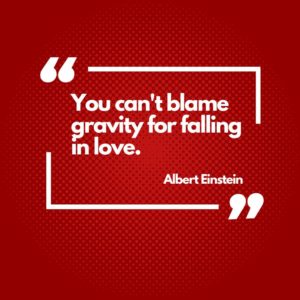Albert Einstein once whimsically noted, “You can’t blame gravity for falling in love.” This intriguing statement not only showcases Einstein’s well-known penchant for wit but also elegantly captures the enigmatic and irresistible nature of love. When we think of gravity, we think of an invisible force that pulls us towards the earth, a fundamental interaction that is both relentless and beyond our control. Isn’t love, in many ways, quite similar? It’s an unseen force that draws us inexplicably towards another person, often against all logic and reason.
So, if it isn’t gravity that pulls us into love’s unpredictable orbit, then what mysterious forces are at play when we fall head over heels? Let’s delve into the science and emotion behind attraction, exploring how something as intangible as love can feel as real and forceful as the physical law that keeps our feet on the ground.
The Science Behind Attraction
While love might feel like an ethereal, intangible phenomenon, there are concrete biological and psychological forces at work when we feel attracted to someone. Let’s explore the fascinating science behind attraction, which explains not just whom we find appealing, but why we might feel that instant ‘click’ or deep connection with another person.
Biological Foundations of Attraction
Attraction isn’t just about chance encounters or shared interests; it’s deeply rooted in our biology. When we meet someone who sparks our interest, our body responds before we even know it. Pheromones, invisible chemical signals that all humans emit, play a crucial role in this process. These scent signals are designed to attract and are processed subconsciously by the olfactory system, influencing our behaviour and perceptions of compatibility with potential partners.
role in this process. These scent signals are designed to attract and are processed subconsciously by the olfactory system, influencing our behaviour and perceptions of compatibility with potential partners.
Another key player is dopamine, a neurotransmitter often referred to as the ‘feel-good hormone.’ When we encounter someone attractive, our brain releases dopamine, triggering a rush of pleasure, excitement, and a craving for more. This biochemical response is akin to the high experienced from certain drugs or the thrill of a new adventure, compelling us to pursue the source of this euphoria.
Psychological Aspects of Attraction
Beyond the chemistry of hormones, psychological factors significantly influence whom we find attractive. Theories of attraction highlight several key elements:
Similarity
We are naturally drawn to individuals who share similar interests, beliefs, and values. This mirroring reinforces our worldview and provides a foundation for shared experiences and understanding.
Proximity
The mere exposure effect suggests that we are more likely to develop attraction to people we encounter regularly. Proximity increases familiarity and comfort, building a foundation for attraction.
Physical Attractiveness
While beauty is subjective, physical attractiveness plays a significant role in initial attraction. This often involves subconscious assessments that gauge health, fertility, and genetic fitness, which evolutionary biologists argue contribute to our mating choices.
When understanding these underlying forces, we gain insights into the complexities of human attraction. It’s not merely about the alignments of the stars or the mysterious forces of the universe; it’s also about the intricate dance of molecules and mindsets that draw us irresistibly towards others.
Emotional Gravity – How Love Pulls Us In
Just as gravity is an ever-present force that grounds us, the emotional aspects of love hold a powerful sway over our hearts and minds, drawing us closer to others in an almost preordained manner. This section explores the compelling emotional dynamics that make love feel inevitable and inescapable.
The Inevitability of Emotional Connection
Falling in love often feels like a force beyond our control, an emotional gravity that pulls us towards another person with an intensity that can be both exhilarating and overwhelming. Psychologist Robert Sternberg’s Triangular Theory of Love suggests that love is composed of three elements: intimacy, passion, and commitment. Each of these components contributes to the feeling of inevitability in love. Intimacy fosters a deep connection, passion ignites desire and attraction, and commitment ensures the longevity and stability of the relationship.
The Gravitational Pull of Emotions
Like the unseen force of gravity that holds planets in orbit, emotional connections can keep two people bound together. The emotional aspects of love—joy, trust, and understanding—act as the glue that maintains the bond, even when challenged by distance or difficulties. Philosopher Alain de Botton suggests that “Love is a skill rather than an enthusiasm.” Approaching love as a skill highlights the deliberate efforts required to nurture and maintain it, much like maintaining one’s balance while caught in a gravitational pull.
Illustrative Anecdotes and Quotes
To further illustrate the power of emotional gravity in love, consider the words of Maya Angelou, who famously said, “Love recognizes no barriers. It jumps hurdles, leaps fences, penetrates walls to arrive at its destination full of hope.” Her words encapsulate the dynamic and unstoppable nature of love, which defies obstacles and flourishes against the odds.
An anecdote that captures this emotional gravity might involve a couple who met unexpectedly, their connection forged in the crucible of shared experiences and challenges. Despite numerous obstacles, their mutual support and understanding created an emotional gravity strong enough to keep them united.
Cultural and Social Influences on Love
Love, a universal emotion, is experienced and expressed differently across the world, shaped profoundly by cultural contexts and societal norms. This section delves into how these influences mould our perceptions and experiences of love, and how media and literature serve to propagate specific romantic ideals.
Variations in Cultural Perceptions of Love
Different cultures have distinct narratives and practices surrounding love, which can influence everything from the way love is expressed to how relationships are structured. For instance, in many Western cultures, love is often portrayed as an essential foundation for marriage, characterised by individual choice and emotional connection. In contrast, some Eastern cultures might emphasise the role of family, duty, and long-term commitment over romantic love, sometimes even arranging marriages to strengthen familial or economic ties.
The concept of “romantic love” itself varies widely. In places like France, love might be seen as passionate and dramatic, whereas in countries such as Japan, love may be expressed more subtly, emphasising harmony and loyalty. These cultural nuances significantly affect how individuals interpret and prioritise love in their lives.
Influence of Societal Norms
Societal norms play a crucial role in defining what is considered acceptable or desirable in a relationship. Norms can dictate who can love whom, how love should be shown, and what constitutes a successful relationship. For example, the growing acceptance of diverse relationship models in many societies, including same-sex and non-monogamous relationships, reflects broader changes in social attitudes towards love and partnership.
The Role of Media and Literature
Media and literature are powerful conduits for romantic ideals. They not only reflect cultural values but also shape them by reinforcing or challenging prevailing notions of love. Classic literature like Jane Austen’s novels often explore the complexities of love within the constraints of societal expectations, while modern films and television can either perpetuate idealised notions of romance or provide more nuanced, realistic portrayals.
The impact of social media also cannot be overlooked. It shapes expectations about relationships and self-worth, often idealising certain relationship milestones and aesthetics, which can lead to pressure to conform to an idealised image of love and partnership.
Navigating Love’s Orbit
Falling in love can feel like being swept off your feet, but sustaining that love requires a grounded approach. Once the initial thrill of a new relationship subsides, the real work of building and maintaining a lasting bond begins. Here, we explore practical advice and strategies to help couples navigate and sustain their relationship over the long term.
The Cornerstones of a Lasting Relationship
Communication
Open, honest, and consistent communication is the lifeline of any relationship. It involves not just talking about your day but also sharing your feelings, fears, and aspirations. Effective communication helps prevent misunderstandings and builds a foundation of trust. Couples should strive to create a safe space where both partners feel heard and respected.
Mutual Respect
Respect in a relationship means honouring each other’s individuality, differences, and boundaries. It’s about valuing each other’s opinions and needs, even when they differ from your own. Mutual respect fosters a healthy environment where love can flourish.
Shared Experiences
Creating memories together through shared experiences strengthens bonds and reignites the spark of romance. Whether it’s traveling together, pursuing a common hobby, or simply sharing a weekly date night, these activities help couples maintain a close connection beyond the daily routines of life.
Expert Tips for Sustaining Love
Relationship experts often emphasise the importance of keeping the relationship dynamic and engaging. Some tips they suggest include:
- Regular Check-ins: Schedule time each week to check in with each other. This can be a dedicated time to discuss the relationship, address any concerns, and appreciate each other’s efforts.
- Conflict Resolution: Learn to address conflicts constructively. Avoid blame and focus on finding solutions together. Understanding and practicing healthy conflict resolution techniques can significantly improve relationship satisfaction.
- Maintaining Intimacy: Physical and emotional intimacy should not be neglected. Regular expressions of affection, both physical and verbal, help maintain the warmth and closeness necessary for a deep, lasting relationship.
Insights from a Relationship Counsellor
A relationship counsellor might add that understanding each other’s love languages (words of affirmation, acts of service, receiving gifts, quality time, and physical touch) can be incredibly helpful. They might suggest that partners regularly express love in the way that their partner appreciates most, which ensures that the love expressed is also felt.
Conclusion
Albert Einstein once playfully remarked, “You can’t blame gravity for falling in love.” This light-hearted analogy beautifully sets the stage for our exploration into the fascinating dynamics of love. Throughout this article, we’ve delved into the scientific underpinnings, the emotional gravitas, the cultural shaping, and the essential practices that sustain love once it blossoms.
We started by examining the biological and psychological forces that ignite the spark of attraction, noting the role of pheromones, dopamine, and foundational theories of similarity and proximity. We then ventured into the realm of emotional gravity, where love’s pull mirrors the inexorable forces that keep the cosmos in motion, underscoring the inevitable nature of forming deep, emotional connections.
Cultural and societal influences were explored, revealing how different worldviews and media shape our romantic paradigms and expectations. And finally, we discussed practical strategies for navigating the orbit of love—emphasising the importance of communication, mutual respect, and shared experiences in fostering enduring relationships.
As we conclude this journey through the realms of love, consider your own experiences. Have you felt the undeniable pull of emotional gravity? How have your cultural background and personal encounters shaped your understanding of love? Reflect on these questions and more as you navigate the complexities and joys of your relationships, always remembering that though you can’t blame gravity for falling in love, embracing its pull can lead to the most fulfilling of human experiences.






